Mosques: A Sanctuary of Spirituality and Social Unity
(A Report Text)
The following is the report text material for the reading comprehension section with the text entitled ‘Mosques: A Sanctuary of Spirituality and Social Unity’.
The sections in this post are as follows:
- Pre-Reading Activity
- Vocabulary Introduction
- Guided Reading
- Discussing the Grammatical Aspects of the Text
- Assessment
Let us proceed with a comprehensive discussion of each detail as outlined below.
A. Pre-Reading Activity (Watching a Video about Mosques)
To build students’ knowledge about mosques and engage them visually and auditorily, have the students watch the video below.
Before watching, show the students the following questions as their guide in watching the video.
- What is the primary function of a mosque?
- What do people do at mosques?
- How do mosques bring people together?
After watching the video, facilitate a group discussion using the questions above. Form groups of 5 students to discuss the questions. After discussing, ask 1 representative from each group to present the answers to these questions in front of the class.
The teacher gives feedback to students’ answers.
B. Vocabulary Introduction
Have the students learn the following vocabulary (related/technical words) to understand the upcoming text better. Play the audio for each vocabulary word, have the students repeat it, and then discuss the meaning together with the class.
| 1 | Mosque [mɑːsk] | A place of worship for Muslims where they gather for prayer, education, and community activities. | |
| 2 | Masjid [mʌsdʒɪd] | The Arabic word for mosque, meaning “place of prostration. | |
| 3 | Worship [wɜːrʃɪp] | The act of showing reverence and adoration for a deity, in this case, through prayer and religious rituals. | |
| 4 | Prayer [prer] | A spiritual communication with God, which is a fundamental practice in Islam, performed five times daily by Muslims. | |
| 5 | Community [kəˈmjuːnəti] | A group of people who live in the same area or share a common religion, in this context, referring to Muslims who gather at the mosque. | |
| 6 | Minaret [mɪnəˈret] | A tall tower attached to a mosque, from which the call to prayer, or adhan, is announced. | |
| 7 | Adhan [ɑːˈðɑːn] | The Islamic call to prayer, announced from the minaret of a mosque five times a day. | |
| 8 | Musalla [muˈsɑːlə] | The prayer hall in a mosque where worshippers gather to perform their prayers. | |
| 9 | Mecca [mekə] | The holiest city in Islam, located in Saudi Arabia, towards which all Muslims face during prayer. | |
| 10 | Kaaba [kɑːbə] | The most sacred site in Islam, located in the center of the Grand Mosque in Mecca; Muslims face the Kaaba during prayer. | |
| 11 | Qibla [kɪblə] | The direction Muslims face during prayer, which is towards the Kaaba in Mecca. | |
| 12 | Mihrab [miːræb] | A niche in the wall of a mosque that indicates the direction of the qibla. | |
| 13 | Imam [ɪˈmɑːm] | The leader of prayer in a mosque, who stands in front of the mihrab during prayer services. | |
| 14 | Madrasa [məˈdræsə] | An Islamic school, often attached to a mosque, where religious education, including the study of the Quran, is provided. | |
| 15 | Quran [kəˈræn] | The holy book of Islam, believed to be the word of God as revealed to the Prophet Muhammad. | |
| 16 | Islamic Law [ɪzˈlɑːmɪk lɔː] | Also known as Sharia, it is a system of law derived from the Quran and the teachings of the Prophet Muhammad. | |
| 17 | Ramadan [ˈrɑːmədɑːn] | The ninth month of the Islamic lunar calendar, observed by Muslims as a month of fasting, prayer, and reflection. | |
| 18 | Iftar [ˈɪftɑːr] | The meal with which Muslims break their fast after sunset during Ramadan. | |
| 19 | Philanthropy [fɪˈlænθrəpi] | The act of providing charitable aid to those in need, often organized by mosques as part of their community services. | |
| 20 | Spiritual [ˈspɪrɪtʃuəl] | Relating to religious or sacred matters, often referring to the inner essence of religious practices and beliefs. | |
| 21 | Multifaceted [mʌltiˈfæsɪtɪd] | Having many aspects or sides, in this context, referring to the various roles a mosque plays in the life of the community. | |
| 22 | Cultural [ˈkʌltʃərəl] | Relating to the customs, beliefs, and traditions of a community or society, in this case, within the Muslim world. | |
| 23 | Social Activities [ˈsəʊʃl ækˈtɪvəti] | Events and gatherings organized within a community to foster social interaction and support among its members. | |
| 24 | Unity [ˈjuːnəti] | The state of being united or joined as a whole, particularly in a community or religious context. | |
| 25 | Vocational Training [vəʊˈkeɪʃənl ˈtreɪnɪŋ] | Educational programs focused on teaching specific skills for a particular trade or occupation, often provided by mosques to support community members. |
Now, have the students listen to the entire audio of the words to reinforce their understanding.
C. Guided Reading
- First Reading
Have the students carefully read the text while playing the accompanying audio. As they read each paragraph, they can follow along with the audio and view the corresponding image. After reading each paragraph, discuss the main idea and any unfamiliar words with the class to ensure comprehension.
Mosques: A Sanctuary of Spirituality and Social Unity
| A mosque is a place of worship for Muslims, serving as a central point for the community to gather for prayer, education, and social activities. The word “mosque” comes from the Arabic word “masjid,” which means “place of prostration.” Mosques are not only important in religious practice but also in the social and cultural lives of Muslims. In many communities, the mosque is a symbol of unity and plays a crucial role in the everyday lives of Muslims. |  | ||
| Mosques are found all over the world, from small villages to large cities. They vary greatly in size, design, and architectural style, reflecting the diverse cultures and traditions of the Muslim world. Despite these differences, all mosques share certain distinctive features. The most prominent feature is the minaret, a tall tower from which the call to prayer, or adhan, is announced. The prayer hall, or musalla, is the main area where worshippers gather to perform their prayers. This area is usually open and spacious, allowing for large groups to pray together. | 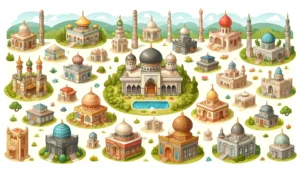 | ||
| One of the most essential aspects of a mosque is its orientation towards Mecca. This is because Muslims are required to face the Kaaba, the holiest site in Islam, during their prayers. The direction towards Mecca is known as the qibla, and it is marked by a niche in the wall called the mihrab. The imam, who leads the prayer, stands in front of the mihrab during the prayer service. | 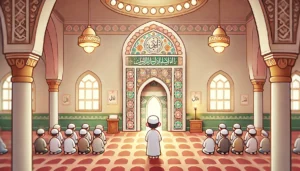 | ||
| Mosques also serve as centers for education. Many mosques have attached schools, known as madrasas, where children and adults can study the Quran, Islamic law, and other subjects. These schools play a vital role in preserving Islamic knowledge and traditions. In addition to religious education, mosques often host lectures, workshops, and community events that address a wide range of topics, from health and social issues to language classes and vocational training. | 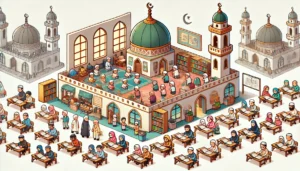 | ||
| Social activities are another key function of mosques. They often serve as community centers where people gather for weddings, funerals, and other important events. During the month of Ramadan, mosques play a particularly important role as they host iftar dinners, where the community breaks its fast together after sunset. Mosques also provide philanthropic services, such as distributing food and clothing to those in need. | 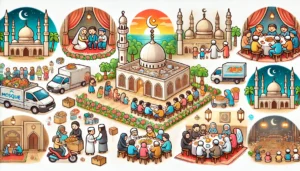 | ||
| In conclusion, mosques are not just places for prayer but are multifaceted institutions that contribute significantly to the spiritual, educational, and social life of Muslim communities. They are places where people come together to worship, learn, and support each other, reflecting the core values of Islam. | 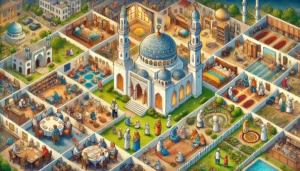 |
- Second Reading
Reread the text with a focus on analyzing the key elements and their significance within the context of the mosque’s role in the community. Use the following guiding questions to facilitate discussion and critical thinking:
Paragraph 1: What are the main roles of mosques in the lives of Muslims? How does the word “mosque” represent its function?
Paragraph 2: What are the main features of a mosque? How do these features serve the needs of the community?
Paragraph 3: Why must mosques face Mecca? What is the significance of the mihrab?
Paragraph 4: How do mosques contribute to education in Muslim communities? What role do madrasas play in protecting Islamic knowledge?
Paragraph 5: How do mosques function as places for social activities? How do these activities bring the community closer together?
Paragraph 6: Summarize the various roles of mosques based on the text. Why are they considered more than just places for prayer?
These questions are designed to help students explore the detailed aspects of the text, encouraging them to think critically about the functions and significance of mosques in Muslim communities.
After finishing discussing 1 paragraph, ask 2 students to voluntarily answer the questions.
The teacher gives feedback to students’ answers.
To reinforce and consolidate their learning, have the students listen to the entire audio or watch the video of the text.
D. Discussion of the Grammatical Aspects of the Text
Review key grammatical aspects of the text with students. Focus on verb tense (the simple present tense) and any specific grammatical forms that are prominent in the text (passive voice). Discuss how these grammatical elements contribute to the overall meaning and clarity of the text. This step ensures that students not only comprehend the content but also appreciate the linguistic features of the text.
(A Report Text)
A mosque is a place of worship for Muslims, serving as a central point for the community to gather for prayer, education, and social activities. The word “mosque” comes from the Arabic word “masjid,” which means “place of prostration.” Mosques are not only important in religious practice but also in the social and cultural lives of Muslims. In many communities, the mosque is a symbol of unity and plays a crucial role in the everyday lives of Muslims.
Mosques are found all over the world, from small villages to large cities. They vary greatly in size, design, and architectural style, reflecting the diverse cultures and traditions of the Muslim world. Despite these differences, all mosques share certain distinctive features. The most prominent feature is the minaret, a tall tower from which the call to prayer, or adhan, is announced. The prayer hall, or musalla, is the main area where worshippers gather to perform their prayers. This area is usually open and spacious, allowing for large groups to pray together.
One of the most essential aspects of a mosque is its orientation towards Mecca. This is because Muslims are required to face the Kaaba, the holiest site in Islam, during their prayers. The direction towards Mecca is known as the qibla, and it is marked by a niche in the wall called the mihrab. The imam, who leads the prayer, stands in front of the mihrab during the prayer service.
Mosques also serve as centers for education. Many mosques have attached schools, known as madrasas, where children and adults can study the Quran, Islamic law, and other subjects. These schools play a vital role in preserving Islamic knowledge and traditions. In addition to religious education, mosques often host lectures, workshops, and community events that address a wide range of topics, from health and social issues to language classes and vocational training.
Social activities are another key function of mosques. They often serve as community centers where people gather for weddings, funerals, and other important events. During the month of Ramadan, mosques play a particularly important role as they host iftar dinners, where the community breaks its fast together after sunset. Mosques also provide philanthropic services, such as distributing food and clothing to those in need.
In conclusion, mosques are not just places for prayer but are multifaceted institutions that contribute significantly to the spiritual, educational, and social life of Muslim communities. They are places where people come together to worship, learn, and support each other, reflecting the core values of Islam.

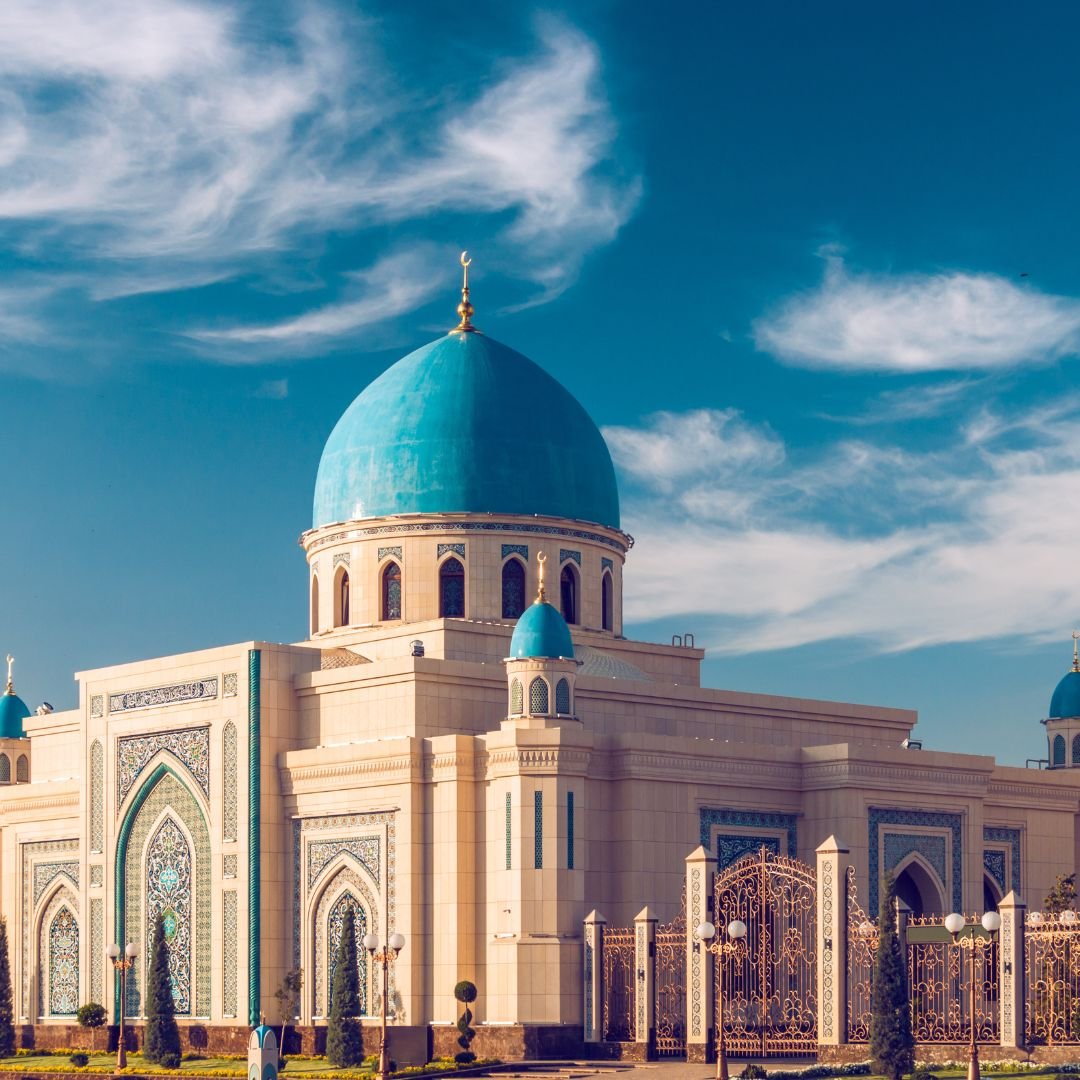
4 responses to “Reading Practice for Intermediate: Mosques: A Sanctuary of Spirituality and Social Unity”
Hello! I could have sworn I’ve been to this blog before but after browsing through some of the post I realized it’s new to me. Anyways, I’m definitely happy I found it and I’ll be book-marking and checking back frequently!
But wanna remark on few general things, The website design and style is perfect, the subject material is real excellent : D.
I enjoy what you guys are up too. This type of clever work and reporting! Keep up the fantastic works guys I’ve included you guys to my blogroll.
Hello my friend! I want to say that this article is amazing, nice written and include almost all important infos. I would like to see more posts like this.